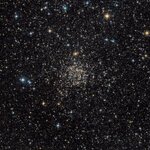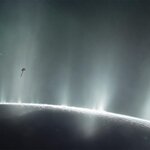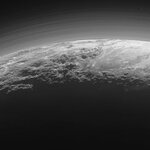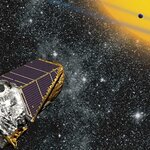Space

A lava tube is just what it sounds like; a cave created when the surface of lava hardens but continues to flow underneath. When that trickles to a halt, the cave is left behind.
These remaining caves exist on Earth and high-resolution pictures taken by interplanetary probes inferred lava tubes on Mars and Luna by observing linear cavities and sinuous collapse chains where the galleries cracked. A new paper measured the size and gathered the morphology of lunar and Martian collapse chains (collapsed lava tubes), using digital terrain models obtained through satellite stereoscopic images…

The origin of carbon in the Milky Way is a mystery but one source of many elements is not: Dying white dwarfs. As those dying stars pass into oblivion, they sprinkle their ashes into the cosmos. These ashes, spread via stellar winds, are enriched with many different chemical elements, including carbon.
The origin of carbon, an element essential to life on Earth, in the Milky Way galaxy is primarily speculation: some are in favor of the idea that low-mass stars blew off their carbon-rich envelopes by stellar winds became white dwarfs, while others place the major site of carbon's synthesis in…

When it comes to evolutionary biology and life on other planets, there is talk of amino acids, the building blocks of our existence.
But for any of that to work we first needed magnetic fields and plate tectonics, and a new paper finds that Earth became a "Goldilocks planet" by getting to the right place at the right time. So if we want to find other forms of life, we need to look for exoplanets that developed earlier rather than later.
Exoplanets are planets orbiting stars in other solars around distant stars and with thousands now known, there is a lot of speculation about how to detect…

How a sunset would appear on other planets is a staple of science-fiction. The sun is as fundamental to grounding our existence as the earth, for most of us. Yet lots of people go months without seeing a sunrise or sunset.
That's extreme, but even more extreme is how it would look on Titan.
A Uranian sunset, for example, is a rich azure that fades into royal blue with hints of turquoise. This blue-green color comes from the interaction of sunlight with the planet’s atmosphere. When sunlight — which is made up of all the colors of the rainbow — reaches Uranus’s atmosphere, hydrogen,…

Though we've only detected a few thousand exoplanets, there are likely 6,000,000,000 Earth-like ones out there, and that means millions could be "ocean worlds" capable of supporting life.
Right now, our knowledge of ocean worlds is limited to moons like Enceladus around Saturn and Europa around Jupiter. Plumes of water erupt from Europa and Enceladus, so we can tell that these bodies have subsurface oceans beneath their ice shells, and they have energy that drives the plumes, which are two requirements for life as we know it
A new model estimated whether -- hypothetically -- there are planets…

Pluto, along with many other dwarf planets in the outer solar system, is often thought of as dark, icy and barren – with a surface temperature of just −230°C.
But now a new study, published in Nature Geoscience, suggests that the body has had a warm interior ever since it formed, and may still have a liquid, internal ocean under its icy crust.
It could mean that other sizable icy dwarf planets may have had early internal oceans too, with some possibly persisting today. This is exciting, as where there’s warm water, there could be life.
Near-sunset view of Pluto’s rugged,…

How big is the universe? No one really knows, but since we are in just one Orion spur of the arm of Sagittarius in one galaxy, and there are an unknown number of galaxies, it's big. So big our galaxy alone could have 6,000,000,000 planets like ours, according to a new estimate.
To be a potential planet like Earth, the new model estimating the number of planets like ours must be rocky, roughly Earth-sized and orbiting Sol-like (G-type) stars. It also has to orbit in the habitable zones of its star, which is the range of distances from a star in which a rocky planet could host liquid water…

A new paper uses a combination of cosmic voids – large expanding bubbles of space containing very few galaxies – and the faint imprint of sound waves in the very early Universe, known as baryon acoustic oscillations, that can be seen in the distribution of galaxies, to show how large structures in the distribution of galaxies in the Universe can provide the most precise tests of dark energy and cosmic expansion yet.
Dark energy is the lesser-known cousin of dark matter. The matter of the universe, what we can detect, can only account for about 5 percent of what is out there. Using inference,…

When a SpaceX crewed Dragon launches atop a Falcon 9 carrying the first astronauts launched from American soil by the United States, they will be making history, setting NASA on a trajectory for the Moon and beyond. For a long time, private companies being able to put humans into orbit has been a dream. Since 2001 A Space Odyssey, made before the Apollo program landed people on the Moon, sci fi envisioned it being possible to take a Pan Am flight on a Space Shuttle like vehicle up to a space station. One with airliner seating no less. Then to connect to a flight to the Moon…

The galaxy, named R5519, is 11 billion light-years from our Solar System and it is making stars at a rate 50 times greater than the Milky Way. The hole at its centre is truly massive, with a diameter two billion times longer than the distance between the Earth and the Sun.
That means it is three million times bigger than the diameter of the supermassive black hole in the galaxy Messier 87, which in 2019 became the first ever to be directly imaged.
Astronomers have captured an image of this "cosmic ring of fire" as it existed 11 billion years ago. It was roughly the mass of the Milky Way…